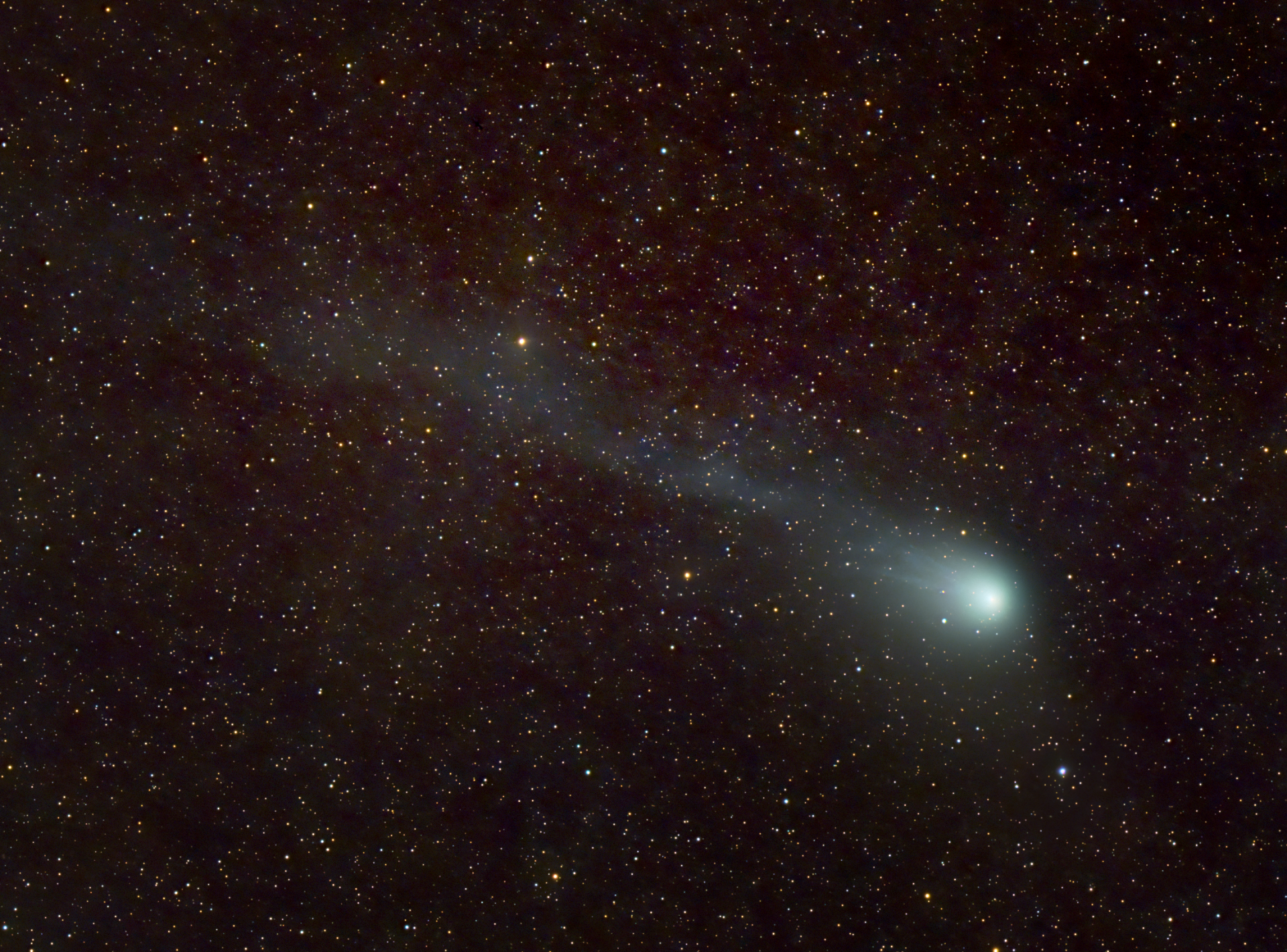Dan Bartlett
When periodic Comet 13P/Olbers last passed perihelion in June 1956 I was not quite three and unaware that comets would become a future passion. I’m delighted to be around for its current apparition because I’ll surely be in the ground for the next. We borrow comet dust in human form and flash our tails for a time before departing on our own personal journey back to the “Oort Cloud” of unknowing. Carpe cometam! That’s my motto and why I’ll be regularly visiting 13P/Olbers this summer.
Alan Hale, c0-discoverer of Hale-Bopp (C/1995 O1), recovered 13P/Olbers photographically at 22nd magnitude last August, and it will come to perihelion 1.2 astronomical units from the Sun on June 30th. Closest approach to Earth occurs on July 20th at 1.9 a.u. Right now, the tempting target sits in Auriga suspended between Castor and Pollux and the pentagonal outline of the celestial Charioteer very low in the northwestern sky at dusk. During its previous appearance in June 1956 the comet peaked at around magnitude 6.5 under similar observing circumstances. We expect it to reach nearly the same brightness by month’s end.

Bob King
Already, 13P/Olbers is a binocular object — I saw it faintly in my 10×50s at magnitude 7.5 on June 1st. The view through my 15-inch Dob at 64× and 142× revealed a round, 2′-wide coma with a bright, compact nuclear region resembling a blurry star. I also caught sight of some haziness to the northeast of the coma which averted vision nailed down as a 4.5′-long ion tail.

Would that the comet were higher in the sky! Even from my observing site (latitude 47° north), where part of Auriga is circumpolar, Comet 13P/Olbers stands only 9° high in late twilight early this month. Dob owners, bring a kneepad! I forgot mine recently and had to sit down on the wet, clay-and-gravel road to view the low-altitude object. Dashing across space and time with our telescopes is all well and good but accommodations need not be spartan.

Stellarium with additions by Bob King
You’d think the viewing window for such a northerly declination comet would be even less from say, latitude 40° north, but with a half-hour shaved from twilight due to the lower latitude, the comet is nearly as high from the central U.S. as it is from farther north where twilight lingers longer. So don’t pass up the opportunity — it might be your one and only chance to see 13P/Olbers. Plan to start watching before the end of astronomical twilight. I picked the comet up in binoculars at 10:50 p.m. — 35 minutes before the start of true darkness —when it was also easy to see in the scope.
The periodic visitor’s altitude slowly increases over time as it crawls from Auriga into Lynx. Come early July it stands some 15° high in late twilight and keeps climbing into August even as it fades to magnitude 8.

Top: ESO, Vernazza et. al; bottom: NASA / JPL-Caltech
Heinrich Olbers discovered the comet that bears his name on March 6, 1815. In late April that year it became a naked-eye object at around magnitude 5. Olbers was an original member of the celestial police, a group of late-18th-century astronomers tasked with discovering a suspected but unseen planet orbiting between Mars and Jupiter. Olbers’s efforts netted two of the largest and most famous of them, Pallas and Vesta. At the time they were considered planets until redefined as asteroids in the mid-19th century.
Olbers also pondered the supposed infinitude of the universe by asking an innocent question: Why is the night sky dark? If the universe were infinite the number of stars should also be infinite. And if that’s so, the entire sky would blaze brightly with stars stacked infinitely in every direction. Since that’s not the case, it implies that the cosmos, or at least what we can see of it, must be finite. This has come to be known as Olbers’s Paradox.
Crazy enough, the comet presents something of its own paradox — it might be better visible in late twilight versus nightfall, when low altitude and atmospheric extinction suppress its brightness.
Pick up a copy of the June issue of Sky & Telescope to catch up with other exciting celestial events in June.


